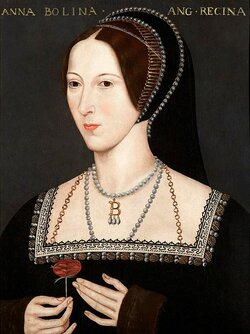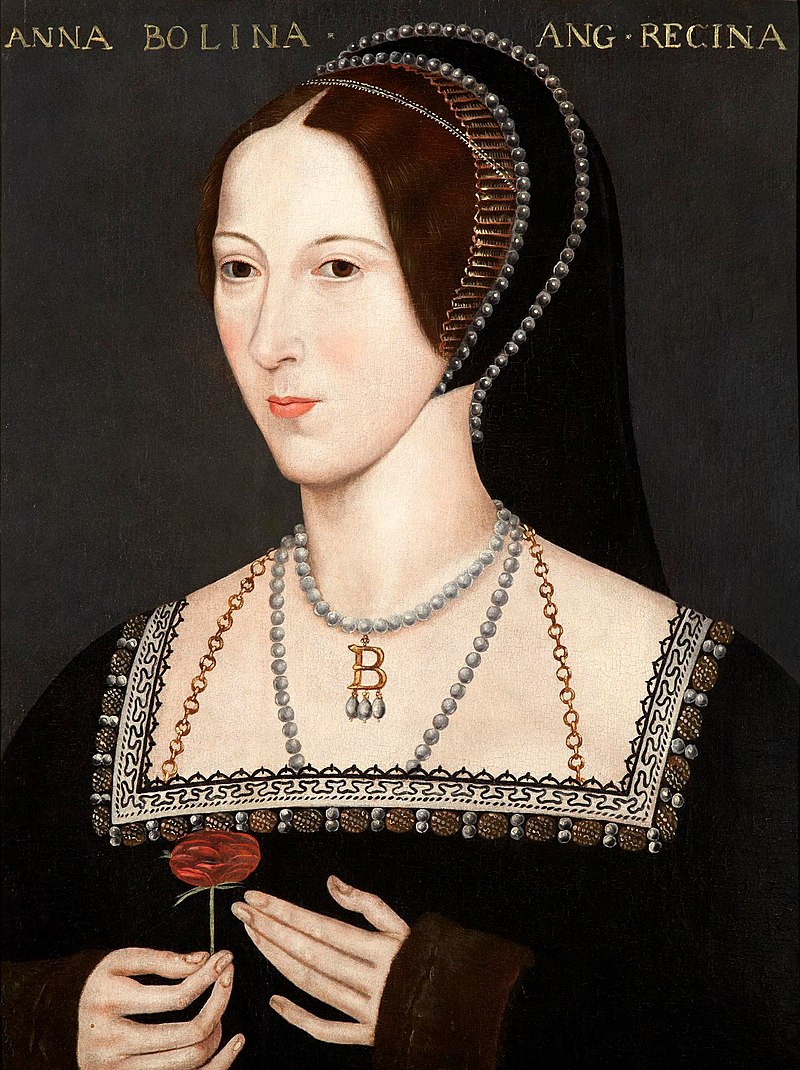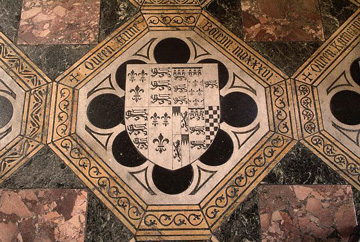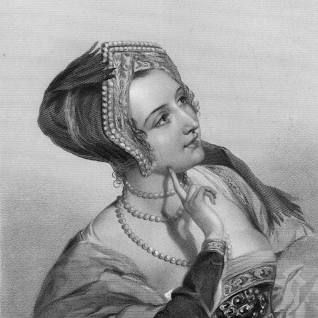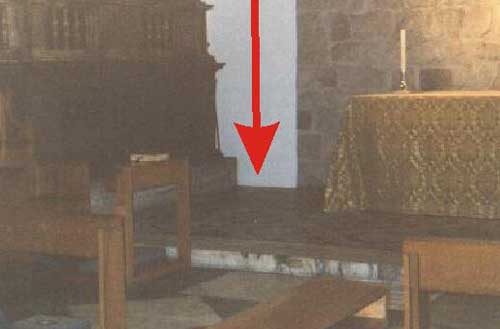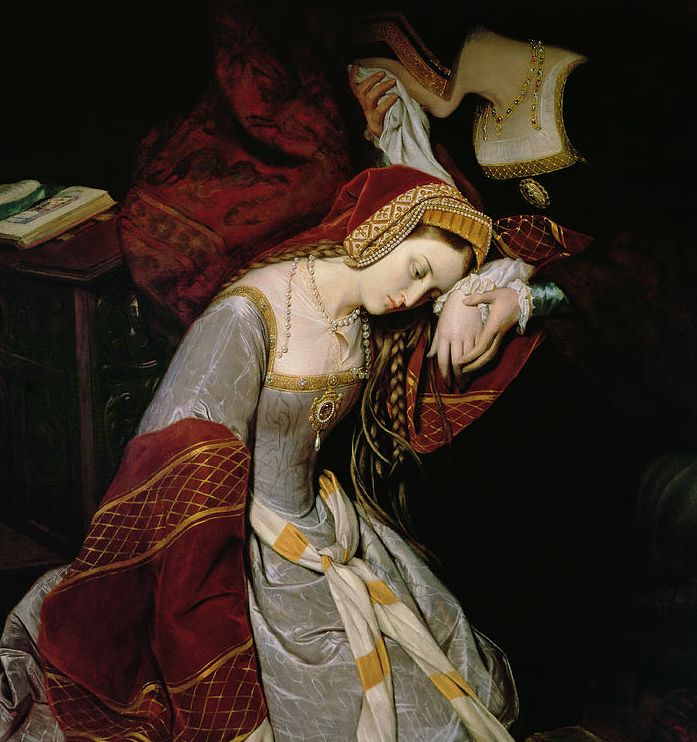She was the 4th and youngest child of Sir Thomas Boleyn, later Earl of Wiltshire and Earl of Ormond, and his wife, Lady Elizabeth Howard, daughter of Thomas Howard, 2nd Duke of Norfolk. The exact year of her birth has been disputed by historians, with some saying she was born around 1501, while others advocate she was born around 1507. Her father was a well-respected diplomat with a gift for languages and was also a favorite of King Henry VII of England, who sent him on many diplomatic missions abroad.
Her early education was typical for women of her class and she spent the majority of her life in Europe. In 1513, she was invited to join the schoolroom of Archduchess Margaret of Austria, the daughter of Holy Roman Emperor Maximilian I, who ruled the Netherlands on her father's behalf. In October 1514, her father arranged for her to attend Henry VIII's sister Mary, who was soon to marry Louis XII of France. In France, she served as a maid of honor to French Queen Mary, and then Mary's 15-year-old stepdaughter Queen Claude, with whom she stayed nearly 7 years. In the Queen's household, she completed her study of French and developed interests in art, fashion, illuminated manuscripts, literature, music, poetry, and religious philosophy. She also acquired knowledge of French art, culture, dance, etiquette, literature, music, and poetry and came to gain experience in flirtation and the game of courtly love.
In 1522, she was called back to England to marry her Irish cousin, James Butler, the 9th Earl of Ormond, who was living at the English court. The marriage plans ended in failure and she secured a post at court as maid of honor to Henry VIII's first wife, Katharine of Aragon. In early 1523, there was a secret betrothal between her and Henry Percy, son of the 5th Earl of Northumberland, and, in January 1524, Cardinal Thomas Wolsey broke the betrothal, and she was sent back to her father's home in Hever Castle.
Around February 1526, Henry VIII began his pursuit of Anne. She initially resisted his attempts to seduce her, refusing to become his mistress which her older sister Mary had been, but within a year, he proposed marriage to her, and she accepted. Both assumed that he could obtain an annulment with Queen Katharine within a matter of months. When it became clear that Pope Clement VII would not annul the marriage, the breaking of the power of the Catholic Church in England began.
In 1531, two years before Henry's marriage to Anne, Queen Katharine was banished from the English court and her rooms were given to Anne. In 1532, Henry granted her the Marquessate of Pembroke, an appropriate peerage for a future Queen. On January 25, 1533, Henry and Anne were married, and, on May 23, 1533, Archbishop of Canterbury Thomas Cranmer declared Henry and Katharine's marriage null and void. Five days later, he declared Henry and Anne's marriage to be good and valid. Shortly afterwards, Pope Clement VII decreed sentences of excommunication against Henry and Cranmer. As a result of this marriage and these excommunications, the first break between the Church of England and Rome took place and the Church of England was brought under the King's control.
Anne was crowned Queen of England on June 1, 1533. In September of that year, she gave birth to the future Queen Elizabeth I, whose gender disappointed Henry. He was not entirely discouraged, for he said that a son would surely follow and professed to love Elizabeth. Three miscarriages soon followed, and, by March 1536, Henry was courting Jane Seymour.
In April 1536, Henry had Anne investigated for high treason. On May 2, she was arrested and sent to the Tower of London where she was tried before a jury of peers including her former betrothed Henry Percy and her own uncle, Thomas Howard. She was found guilty on May 15 and was beheaded 4 days later within the Tower precincts. She was then buried in an unmarked grave in the Tower of London's Chapel of St. Peter ad Vincula (St. Peter in Chains). Her skeleton was identified during renovations of the chapel in 1876, during the reign of Queen Victoria, and her resting place is now marked in the marble floor. Modern historians view the charges against her, which included adultery, incest, and witchcraft, as trumped up and unconvincing.
Following the coronation of her daughter, Elizabeth, as queen, Anne was venerated as a martyr and heroine of the English Reformation, particularly through the works of John Foxe. Over the centuries, she has inspired or been mentioned in numerous artistic and cultural works. As a result, she has retained her hold on the popular imagination and has been called "the most influential and important Queen Consort England has ever had," since she provided the occasion for Henry VIII to annul his marriage to Katharine of Aragon, and declare his independence from Rome. The 1969 British film "Anne of the Thousand Days" tells her story, in which her role was played by actress Genevieve Bujold. In the Showtime television miniseries "The Tudors," she was played by actress Natalie Dormer in 21 episodes from 2007 to 2010.
She was the 4th and youngest child of Sir Thomas Boleyn, later Earl of Wiltshire and Earl of Ormond, and his wife, Lady Elizabeth Howard, daughter of Thomas Howard, 2nd Duke of Norfolk. The exact year of her birth has been disputed by historians, with some saying she was born around 1501, while others advocate she was born around 1507. Her father was a well-respected diplomat with a gift for languages and was also a favorite of King Henry VII of England, who sent him on many diplomatic missions abroad.
Her early education was typical for women of her class and she spent the majority of her life in Europe. In 1513, she was invited to join the schoolroom of Archduchess Margaret of Austria, the daughter of Holy Roman Emperor Maximilian I, who ruled the Netherlands on her father's behalf. In October 1514, her father arranged for her to attend Henry VIII's sister Mary, who was soon to marry Louis XII of France. In France, she served as a maid of honor to French Queen Mary, and then Mary's 15-year-old stepdaughter Queen Claude, with whom she stayed nearly 7 years. In the Queen's household, she completed her study of French and developed interests in art, fashion, illuminated manuscripts, literature, music, poetry, and religious philosophy. She also acquired knowledge of French art, culture, dance, etiquette, literature, music, and poetry and came to gain experience in flirtation and the game of courtly love.
In 1522, she was called back to England to marry her Irish cousin, James Butler, the 9th Earl of Ormond, who was living at the English court. The marriage plans ended in failure and she secured a post at court as maid of honor to Henry VIII's first wife, Katharine of Aragon. In early 1523, there was a secret betrothal between her and Henry Percy, son of the 5th Earl of Northumberland, and, in January 1524, Cardinal Thomas Wolsey broke the betrothal, and she was sent back to her father's home in Hever Castle.
Around February 1526, Henry VIII began his pursuit of Anne. She initially resisted his attempts to seduce her, refusing to become his mistress which her older sister Mary had been, but within a year, he proposed marriage to her, and she accepted. Both assumed that he could obtain an annulment with Queen Katharine within a matter of months. When it became clear that Pope Clement VII would not annul the marriage, the breaking of the power of the Catholic Church in England began.
In 1531, two years before Henry's marriage to Anne, Queen Katharine was banished from the English court and her rooms were given to Anne. In 1532, Henry granted her the Marquessate of Pembroke, an appropriate peerage for a future Queen. On January 25, 1533, Henry and Anne were married, and, on May 23, 1533, Archbishop of Canterbury Thomas Cranmer declared Henry and Katharine's marriage null and void. Five days later, he declared Henry and Anne's marriage to be good and valid. Shortly afterwards, Pope Clement VII decreed sentences of excommunication against Henry and Cranmer. As a result of this marriage and these excommunications, the first break between the Church of England and Rome took place and the Church of England was brought under the King's control.
Anne was crowned Queen of England on June 1, 1533. In September of that year, she gave birth to the future Queen Elizabeth I, whose gender disappointed Henry. He was not entirely discouraged, for he said that a son would surely follow and professed to love Elizabeth. Three miscarriages soon followed, and, by March 1536, Henry was courting Jane Seymour.
In April 1536, Henry had Anne investigated for high treason. On May 2, she was arrested and sent to the Tower of London where she was tried before a jury of peers including her former betrothed Henry Percy and her own uncle, Thomas Howard. She was found guilty on May 15 and was beheaded 4 days later within the Tower precincts. She was then buried in an unmarked grave in the Tower of London's Chapel of St. Peter ad Vincula (St. Peter in Chains). Her skeleton was identified during renovations of the chapel in 1876, during the reign of Queen Victoria, and her resting place is now marked in the marble floor. Modern historians view the charges against her, which included adultery, incest, and witchcraft, as trumped up and unconvincing.
Following the coronation of her daughter, Elizabeth, as queen, Anne was venerated as a martyr and heroine of the English Reformation, particularly through the works of John Foxe. Over the centuries, she has inspired or been mentioned in numerous artistic and cultural works. As a result, she has retained her hold on the popular imagination and has been called "the most influential and important Queen Consort England has ever had," since she provided the occasion for Henry VIII to annul his marriage to Katharine of Aragon, and declare his independence from Rome. The 1969 British film "Anne of the Thousand Days" tells her story, in which her role was played by actress Genevieve Bujold. In the Showtime television miniseries "The Tudors," she was played by actress Natalie Dormer in 21 episodes from 2007 to 2010.
Bio by: William Bjornstad
Family Members
Advertisement
See more Boleyn memorials in:
Records on Ancestry
Sponsored by Ancestry
Advertisement
